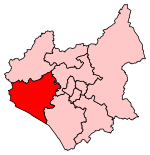Market Bosworth Rural District
Districts of England abolished by the Local Government Act 1972Districts of England created by the Local Government Act 1894History of LeicestershireLeicestershire geography stubsLocal government in Leicestershire ... and 2 more
Rural districts of EnglandUse British English from August 2012
The rural district of Market Bosworth existed from 1894 to 1974 in Leicestershire, England. It was named after Market Bosworth, and was created under the Local Government Act 1894, based on the Market Bosworth rural sanitary district, and that part of the Atherstone rural sanitary district which was in Leicestershire. The parish of Higham on the Hill was added in 1936, from the Hinckley Rural District, which had been abolished under a County Review Order. In 1974 most of the district merged with Hinckley to form the new Hinckley and Bosworth district, apart from Ibstock, which went to North West Leicestershire.
Excerpt from the Wikipedia article Market Bosworth Rural District (License: CC BY-SA 3.0, Authors).Market Bosworth Rural District
Sutton Lane, Hinckley and Bosworth Market Bosworth
Geographical coordinates (GPS) Address Nearby Places Show on map
Geographical coordinates (GPS)
| Latitude | Longitude |
|---|---|
| N 52.62 ° | E -1.4 ° |
Address
Sutton Lane
Sutton Lane
CV13 0LB Hinckley and Bosworth, Market Bosworth
England, United Kingdom
Open on Google Maps







